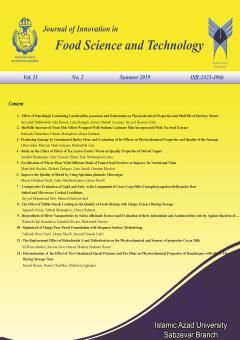تاثیر خمیرترش حاوی لاکتوباسیلوسپاراکازئی و فرمنتوم بر خصوصیات فیزیکوشیمیایی و ماندگاری نان بربری
الموضوعات :لیلا ناطقی 1 , محبوبه سادات رسول 2 , علیرضا شهاب لواسانی 3 , سید حسین استیری 4
1 - عضو هیات علمی تمام وقت دانشگاه آزاد اسلامی - واحد ورامین پیشوا
2 - دانشگاه آزاد اسلامی واحد ورامین پیشوا
3 - دانشگاه آزاد اسلامی،واحد ورامین پیشوا،گروه علوم و صنایع غذایی ، ورامین- ایران
4 - گروه علوم و صنایع غذایی،واحد سبزوار،دانشگاه آزاد اسلامی، سبزوار
الکلمات المفتاحية: نان بربری, لاکتوباسیلوس پاراکازئی, خمیرترش, لاکتوباسیلوس فرمنتوم,
ملخص المقالة :
استفاده از خمیر ترش در تهیه نان علاوه بر بهبود عطر و طعم و ارزش تغذیهای نان، سبب افزایش ماندگاری نان نیز میگردد. هدف از این مطالعه، بررسی تاثیر بکارگیری باکتریهای لاکتیکی شامل لاکتوباسیلوس پارا کازئی و لاکتوباسیلوسفرمنتوم در خمیرترش بر کیفیت نان بربری بود. هفت تیمار مطابق با طرح کاملا تصادفی شامل نان بربری حاوی باکتریهای لاکتیکی لاکتوباسیلوسپاراکازئی و لاکتوباسیلوسفرمنتوم به مقدارcfu/ml106به صورت منفرد و همچنین به صورت ترکیبی به مقدارcfu/ml103 و تیمار شاهد (نان بربری بدون باکتریهای لاکتیکی) با زمان تخمیر اولیه 10 و 40 دقیقه طراحی گردید. آزمایشات انجام شده روی تیمارها 24، 48 و 72 ساعت پس از تولید شامل ویژگیهای فیزیکوشیمیایی (حجم مخصوص، pH و رطوبت)، آزمایشات میکروبی شامل بررسی میزان رشد کپک، میزان اسید استیک و اسید پروپیونیک، ارزیابی بافت و آزمونهای حسی بود. نتایج حاصل از بررسیها نشان داد که استفاده از باکتریهای لاکتیکی اثر معنیداری روی کاهش pH، افزایش رطوبت، افزایش حجم مخصوص، کاهش سفتی بافت، افزایش میزان اسید استیک و پروپیونیک، جلوگیری از کپک زدگی و بهبود خواص حسی نان بربری در مقایسه با شاهد داشت. بالاترین امتیاز پذیرش کلی در آزمون حسی مربوط به تیمار خمیر ترش حاوی cfu/g 103 لاکتوباسیلوس فرمنتوم + cfu/g 103 لاکتوباسیلوس پاراکازئی + 2 درصد وزن آرد مخمر نانوایی+ 40 دقیقه زمان تخمیر اولیه بود. بنابراین با استفاده از خمیر ترش حاوی مخلوط باکتریهای لاکتیکی و افزایش زمان تخمیر اولیه میتوان نان بربری با خواص کیفی مطلوبتری در مقایسه با شاهد تولید نمود.
15.AACC. 2000. Approved methods of the American association of cereal chemists (methods, 10-05, 44-14, 74-09, 74-30). St. Paul, Minnesota: American Association of Cereal Chemists.
16.Arendt, E.K. Ryan, L.A.M. and Bello, F.D. 2007. Impact of sourdoughon the texture of bread. Food Microbiology, 24(2): 165-174.
17..Baker, J. C., Parker, H. K. and Fortmann, K. L. 1953. Flavour of bread. Cereal Chemistry, 30: 22-30.
18.Corsetti, A.. Gobbetti, B., De Marco, B., Balestrieri, F., Paoletti, F. and Rossi, J. 2000. Combined effect of sourdough lactic acid bacteria and additives on bread firmness and staling. Journal of Agricultural and Food Chemistry, 48:3044-3051.
19.Clarke, C.I., Schober, T.J. and Arendt, E.K. 2002. The effect of single strain and traditional mixed strain starter cultures on rheological properties of wheat dough and bread quality.Cereal Chemistry, 79: 640-647.
20..Elke,K.., laam, A., Ryan, A.M. and Dal Bello,F. 2006. Impact of sourdough on the texure bread . food Microbiolgy, 24(2):165-174.
21.Gargari, BP., Mahboob, S. and Razavieh, SV. 2007. Content of phytic acid and its mole ratio to zinc in flour and breads consumed in Tabriz, Iran.
Journal of Food Chemistry, 100(3): 1115-119.
22.Gul, H., zcelik, S., Sagdic, O. and Certel, M. 2005. Sourdough bread production with lactobacilli and saccharomycescerevisiae isolated from sourdoughs. Process Biochemistry, 40, 691-697.
23.Korakli, M., Rossmann, A., Gänzle, G. and Vogel, R.F. 2001. Sucrose metabolism and exopolysaccharide production in wheat and rye sourdoughs by Lactobacillus sanfranciscensis .Journal of Agricultural and Food Chemistry impact factor, 49, 5194-5200.
24.Katina, K., Arendt, E., Liukkonen, K.H., Autio, K., Flander, L.and Poutanen, K. 2005. Potential of sourdough for healthier cereal products. Trends food science and technology, 16, 104-112.
25.Mikelsaar, M. and Zilmer, M. 2009. Lactobacillus fermentum ME-3 An antimicrobial and antioxidative probiotic . Microbial Ecology in Health and Disease, 21(1): 1-27.
26.Plessas, S., Bekatorou, A., Gallanagh, J., Nigam, P., Koutinas, AA. and Psarianos, C. 2008. Evolution of aroma volatiles during storage of sourdough breads madeby mixed cultures of luyveromyces marxianus and Lactobacillus delbrueckii ssp. bulgaricus or Lactobacillus helveticus. Food Chemistry., 107:883-889.
27.Randazzo, CL., Restuccia, C., Romano, AD. and Caggia, C. 2004. "Lactobacillus casei, dominant species in naturally fermented Sicilian green olives". International Journal of Food Microbiology, 90(1): 9–14.
28.Robert, H., Gabriel, V., Lefebvre, D., Rabier, P., Vayssier, Y. and Faucher, C. 2006. Study of the behaviour of Lactobacillus plantarum and Leuconostoc starters during a complete wheat sourdough bread making process. LWT- food science and technology, 39, 256-265.
29.Rehman, Ur., Nawaz, H. S., Hussain. and Ahmad, M.M. 2007. Effect of sourdough bacteria on the quality and shelf life of bread. Pakistan Journal Nutrition, 6 (6): 262-265.
30Wehrle, K..,Crau, H. and Arendt, E. 1997. Effects of lactic acid, acetic acid and table salt on Fundamental rheological dough properties of wheat dough. Cereal chemistry, 74, 739-744.
31.Zlateva, D. and Karadzhov, G. 2008. Sensory quality of bread prepared with leavens of lactic acid bacteria and added amino acids. Forum Ware International, 1, 50-57.


